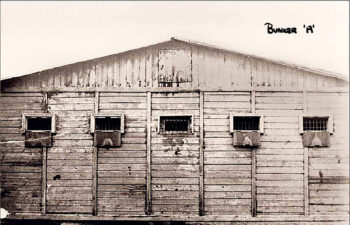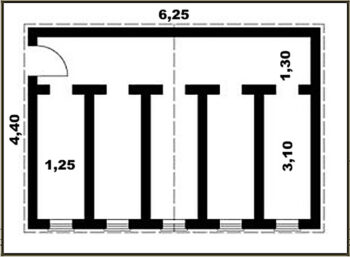Neuengamme
The Neuengamme Concentration Camp was established in 1938 near a village of the same name some 13 miles southeast of Hamburg. Its relevance for Holocaust historiography lies in claims about a few select homicidal gassings in that camp. There is no wartime source for this. No documents confirm any witness claim in this regard, and the building where most witnesses claimed these events occurred was destroyed in 1949 or 1950, leaving only the foundations. In other words, everything depends on claims, and nothing is supported by evidence. However, if the building that allegedly served as a homicidal gas chamber really had the claimed features, it would have been a prime piece of evidence, and the most important exhibit for any future museum. In other words: it would have been preserved at all costs. But it wasn’t.
The first testimonies about homicidal gassings at Neuengamme were deposited in the context of British post-war investigations. They were embedded in the British preparations for their Bergen-Belsen Show Trials, their show trial against Bruno Tesch, and of course the Neuengamme show trial itself. Confessions from some SS men allegedly involved in these crimes were extracted in the context of pervasive threats and torture.

 Floor plan of the detention bunker at Neuengamme Camp.
Floor plan of the detention bunker at Neuengamme Camp.Quite a few witnesses interrogated 25 years later by West-Germany’s judiciary knew nothing about homicidal gassings, or could tell only hearsay stories, so they were ignored. Testimonies of former camp inmates who confirmed gassing claims were accepted at face value, no matter what they stated. Here is a summary of those claims:
- either one or two gassings took place;
- the first gassing occurred either in late 1941 to early 1942, spring or summer 1942, July 1942, September 1942, late September to early October 1942, October 1942, late October to early November 1942, fall 1942, winter 1942-1943, or January 1943;
- the gassing took place either early in the morning, late in the morning, in the afternoon, or in the evening, and lasted either 10 minutes, 20 minutes, 30 minutes, an hour, two hours, or at least four hours;
- either 80, 156, 180-200, 190, 193, 197, 200, 200-250, 250, 251 or as many as 1,400-1,500 altogether fell victim to the first gassing;
- no one witnessed the alleged second gassing or knew anything specific about it, but it allegedly happened either between late 1941 to early 1942, in November 1942, or fall 1942, and it had either 95, over 100, 150, or 251 victims;
- the victims were Soviet PoWs (although maybe Poles for the second gassing), who came either from Lüneburg, from Fallingbostel or from the Göring Factories;
- the building where the crime supposedly unfolded was retrofitted with six or seven pipes in the roof for pouring in Zyklon B, measuring either 8, 10-15, 15 or 38 cm in diameter; the facility’s heating was provided by either a radiator, heating coils, or by electric heating wires, which were located beneath the ceiling or on the walls.
- after the murder, the corpses were loaded either onto a “trailer of a lorry,” also called “car trailer” and “truck trailer,” or “on an open tarp cart,” or onto 3 “transport carts,” or onto “2 or 3 carts,” or onto “four trolleys,” or onto a “car trailer” and “carts” together; the work was carried out by the “corpse-recovery unit” or by the “roll commando”;
If accounts from later, West-German investigations were included in this list, the claims would be even more disparate.
If reading this list in parallel with a similar list of what has been claimed about the alleged first gassing at the Auschwitz Camp, the similarities are striking, down to minute details. Considering that several transports of Auschwitz inmates arrived at the Neuengamme Camp since early 1943, it becomes apparent that the black-propaganda story spread among Auschwitz inmates was simply transplanted to Neuengamme.
The one unique feature setting the claimed Neuengamme gassing(s) apart from all other gassings is the claim that the event is said to have taken place in plain view of the entire camp. Three witnesses even claimed that all camp inmates had to line up for roll call and sing a song while the victims of the gassings were carted by them. This was allegedly a demonstration by the SS of their omnipotence. However, if that tale were true, there would be hundreds, if not thousands of witnesses confirming this. But we only have three, who furthermore contradict one another in other aspects of their claims.
It can be safely assumed that no homicidal gassing at Neuengamme – or anywhere else, for that matter – would have taken place in plain view of the entire camp, or would even have been celebrated by the SS in the presence of all inmates. This claim merely highlights the preposterous nature of this tale and seals the untrustworthiness of the witnesses.
Furthermore, no camp administration would have troubled themselves to convert a normal building into a homicidal gas chamber just for the sake of executing one or two small batches of Soviet PoWs.
As in the case of Auschwitz, orthodox historians aided and abetted the fraudsters in British and West-German judiciary by subsequently transforming this disparate tale of wartime atrocity propaganda into “history” by cherry-picking from the mishmash of claims those that appear conducive to their agenda, while papering over all the cracks in the story in order to hide them from their unsuspecting readers.
Neither the encyclopedia by Gutman (1990) nor that of Rozett/Spector (2000) mentions gassings or a gas chamber in their entry on Neuengamme, although Gutman quotes as his sources two books which very much mention them, while Rozett/Spector have copied from Gutman, as usual, without giving sources.
(For more details on this, see Mattogno/Jansson 2024.)

You need to be a registered user, logged into your account, and your comment must comply with our Acceptable Use Policy, for your comment to get published. (Click here to log in or register.)